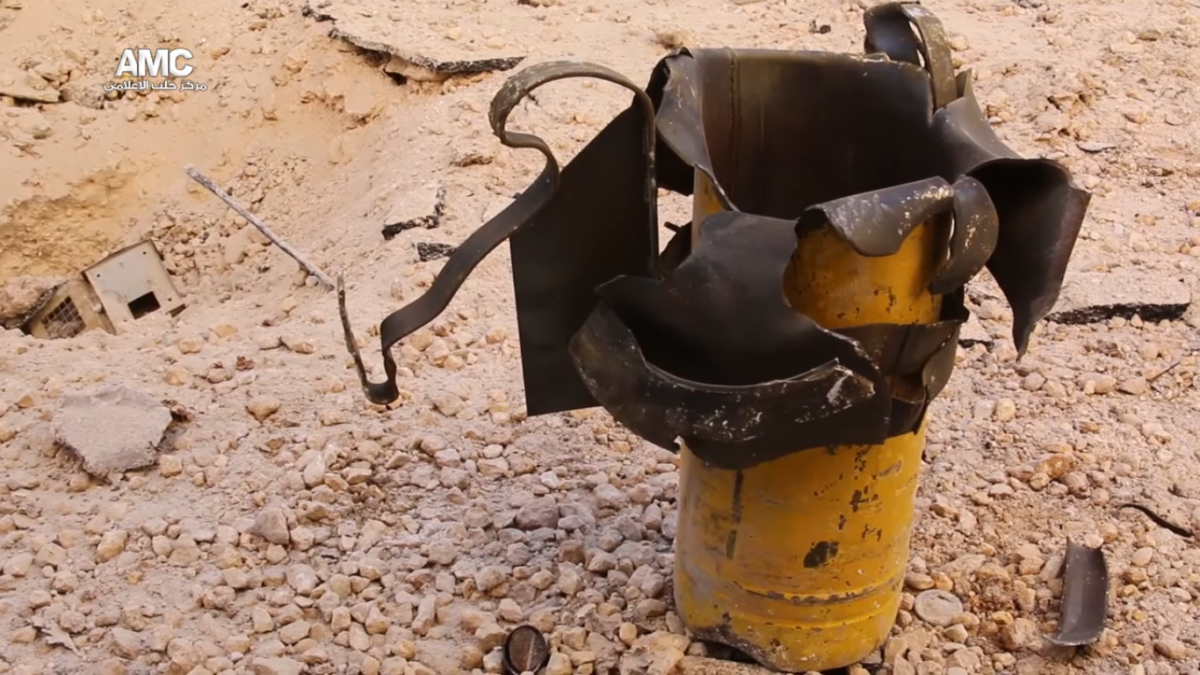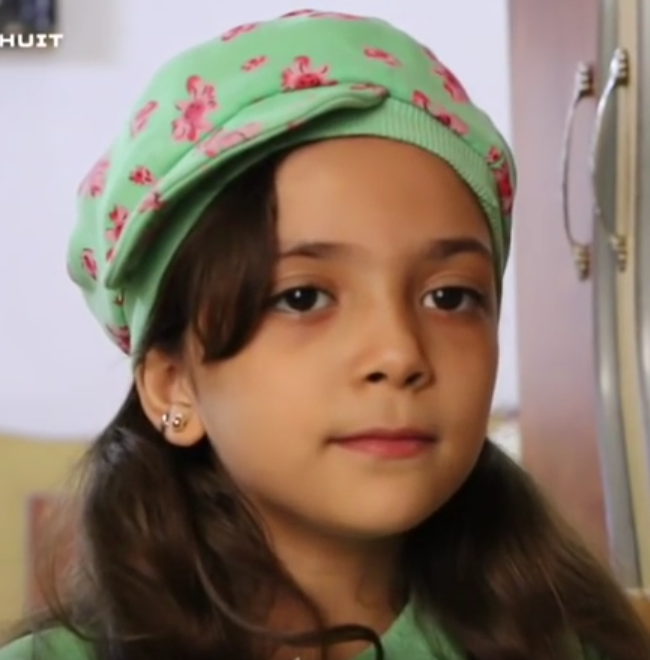The Exit Corridor Shelling in West Aleppo: An Open Source Analysis
This article was written collaboratively with Bellingcat contributors Nick Waters and Hady al-Khatib. Note: All times mentioned are in local time (UTC+3). The times mentioned alongside the videos are no more than a rough estimate.
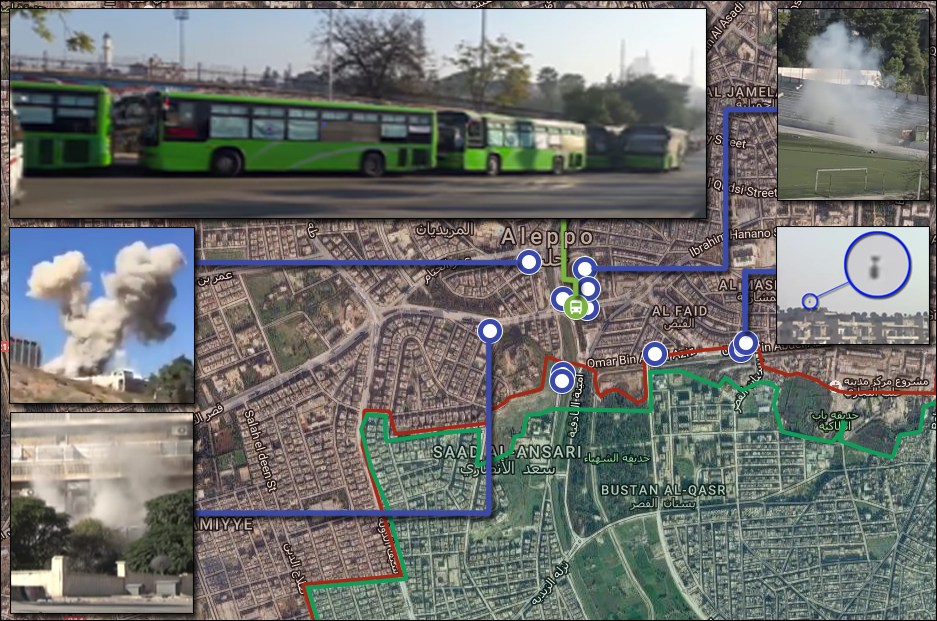
Figure 1 — Overview map of the exit corridor near the 7th April Municipal Stadium in West Aleppo, Syria. (Base map via Google Earth, images (clockwise) via RT, Step News Agency, and Al Masdar News, figure annotated by Bellingcat).
On October 20, 2016, it was reported that an exit corridor set up by the Syrian government in West Aleppo had come under mortar fire. Exit corridors were set up in Aleppo during a unilateral truce by the Syrian government and the Russian Federation to allow civilians and rebel fighters to leave rebel-held parts of Aleppo.
Conflicting claims have arisen related to the attack. For that reason, we aim to collect, geolocate and analyse all related (visual) footage of the incident to examine what we can and cannot know about the exit corridor shelling when using open source information.
Context: The “Humanitarian Pause”
A unilateral truce starting on October 20 was announced by the Russian Federation. No airstrikes by either Syrian or Russian aircraft were reported since Russia began the declared pause in hostilities in the divided city of Aleppo.
As part of the truce, civilians and rebel fighters were offered to leave rebel-held Aleppo by Russia, and eight exit corridors were set-up throughout the city.
Rebels were said to have rejected the plan, the BBC writes, and only a few – if any – civilians were evacuated so far, Ammar Jaber, a correspondent for Dubai-based pro-opposition Orient News claimed based on visits to two different exit corridors. Mr. Jaber “accused the Syrian government forces of targeting the corridors with sniper and rocket fire” (via BBC).
However, Syria’s state-run news agency Syrian Arab News Agency (SANA) blamed “terrorist groups” for the attacks, and the Russian state-run broadcaster Rossiya 24 said members of Jabhat Fateh al-Sham were preventing people from leaving rebel-held Aleppo. A resident of Aleppo, Wissam Zarqa, told the BBC that “none could leave”.
Citizens and rebels were aware of the existence of such exit corridors as flyers were dropped over rebel-held Aleppo by a helicopter of the Syrian Air Force, as shown in a video uploaded to YouTube by Baladi News:
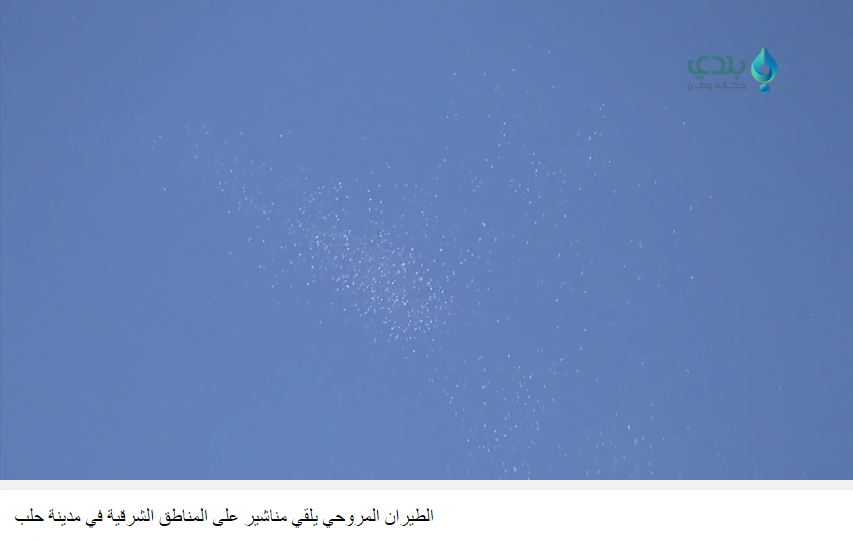
Figure 2 — Still from a Baladi News video showing leaflets being dropped above East Aleppo, Syria. (Courtesy: SANA)
The Syrian Arab News Agency (SANA) also published a video from inside a helicopter, showing the leaflets allegedly being dropped above Aleppo. We have not been able to geolocate the area shown in the video as the quality is low.
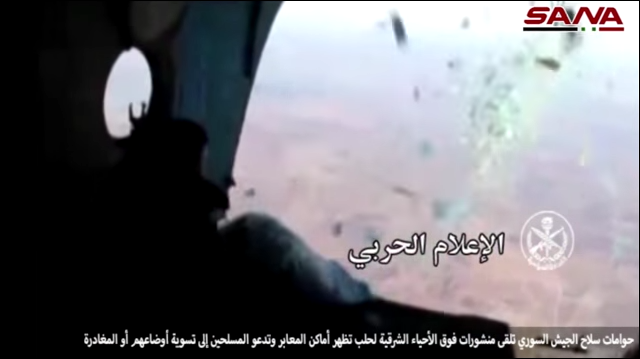
Figure 3 — Still from a SANA video allegedly showing leaflets being dropped above East Aleppo, Syria. (Courtesy: SANA)
The video showed an example of the flyer, copies of which have been shown in photos and videos from rebel-held Aleppo too.
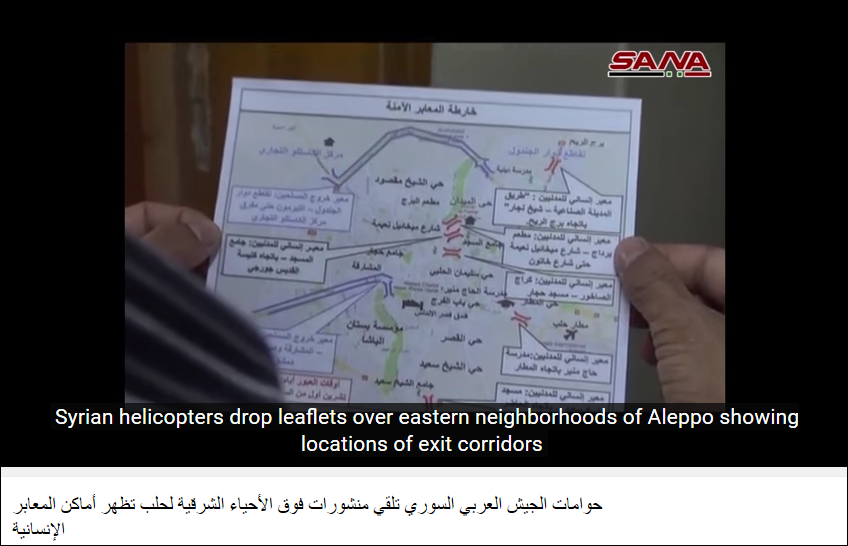
Figure 4 — A leaflet showing the exit corridors in Aleppo as shown in a SANA video. (Courtesy: SANA)
The full flyer is shown below and allows to get a rough indication of where the exit corridors are located. It lists all eight exit corridors controlled by the Syrian Arab Army (SAA), six for civilians and two for armed groups (starting from the top right, then below):
- Humanitarian corridor for civilians:
Industrial City road Sheikh Najar in the direction of Al-Reih Bridge; - Humanitarian corridor for civilians:
Berdag restaurant (the street of Michael Naima until Khanon street); - Humanitarian corridor for civilians:
Al-Sakhour Station until Hjar mosque; - Humanitarian corridor for civilians:
Haj Menber school until the Airport; - Humanitarian corridor for civilians:
The Sheikh Said mosque to the direction of Hader; - Corridor for armed groups:
Al-Kher Market in the Al-Masharqa district until the Damascus—Aleppo road; - Humanitarian corridors for civilians:
From the Masjed mosque until Qedis Giorgy church; - Corridor for armed groups:
The crossing of Jandoul roundabout – Al-Lermon until the corner of Castello commercial center.
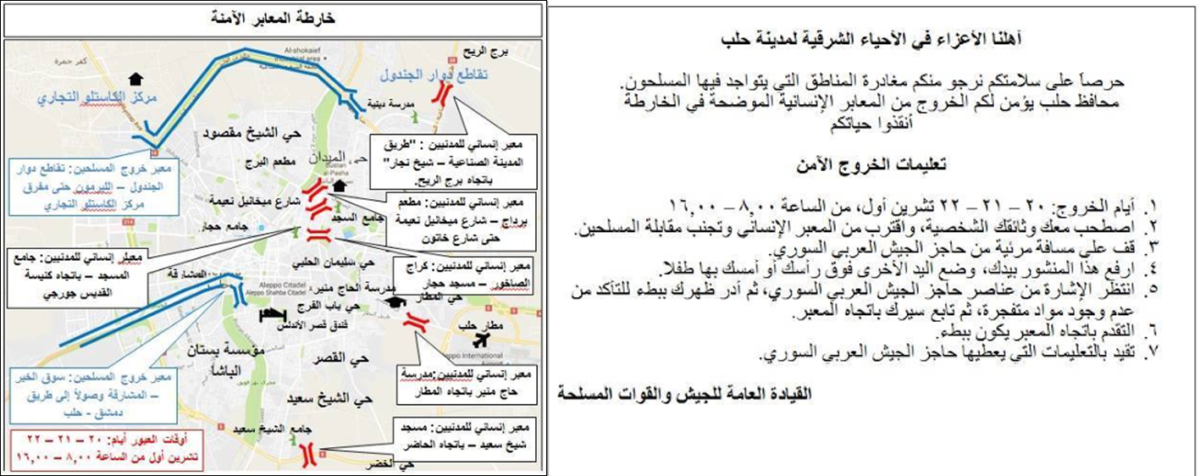
Figure 5 — The two-sided flyer that was dropped above Aleppo’s eastern neighbourhoods.
Due to the lack of media from other checkpoints, this open source analysis concentrates on the exit corridor located near the 7th April Municipal Stadium. That is the armed group exit corridor near the Al-Kher Market in Al-Masharqa until the Damascus—Aleppo road), and an excerpt of that flyer can be used as an overlay on Google Earth satellite imagery:
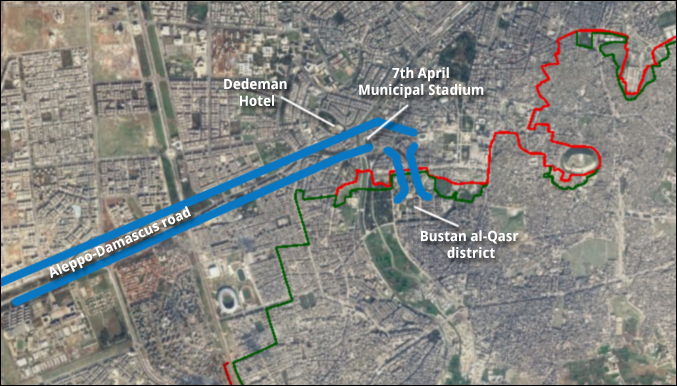
Figure 6 — The exit corridor near the 7th April Municipal Stadium in Aleppo, Syria, as an overlay on Google Earth imagery. (Courtesy satellite imagery: Google Earth)
Videos of mortars and smoke plumes can indeed be geolocated to the area of the exit corridor, as the next section will show.
Geolocation of Smoke Plumes and Falling Mortars
The geolocation of the visual evidence of mortar shelling and what appears to be their impact, namely smoke plumes, will be discussed per source or sources.
Step News Agency video
Step News Agency, a pro-rebel outlet, published a video on October 20, which shows rebels firing a heavy machine gun, the impact of a “hell cannon round” (a weapon used extensively by the rebels), an interview with a rebel commander and a splash from an explosion. The first part of the video was likely filmed in the morning around 8:00, and the second part around 9:00 based on SunCalc.
The interviewed commander claims that: “The regime tried to get into the Bustan Al-Qasr district [in the] early morning but we didn’t allow them to. No civilians from Bab Al-Qasr have left.” Whether this is true or not, we can see that the rebel fire resulted in explosive rounds landing on or near one of the biggest routes to West Aleppo.
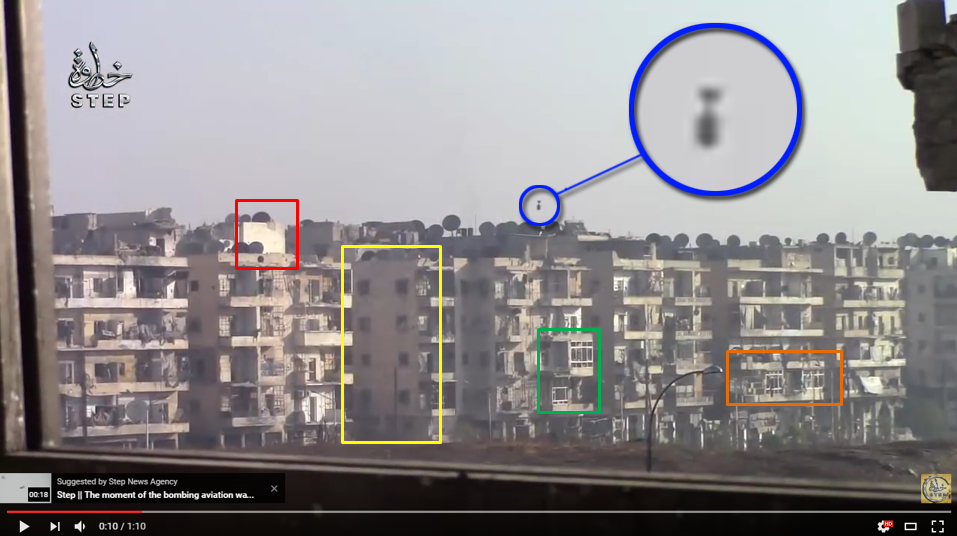
Figure 7 — An annotated still from the Step News Agency video, showing a “hell cannon” round right before impact in the Bustan Az-Zahra district in Aleppo, Syria. (Courtesy: Step News Agency)
A second filming location in the video shows another explosive splash. Both splashes can be geolocated as filmed from the Bustan Al-Qasr district looking northeast to the Al-Masharqa district.
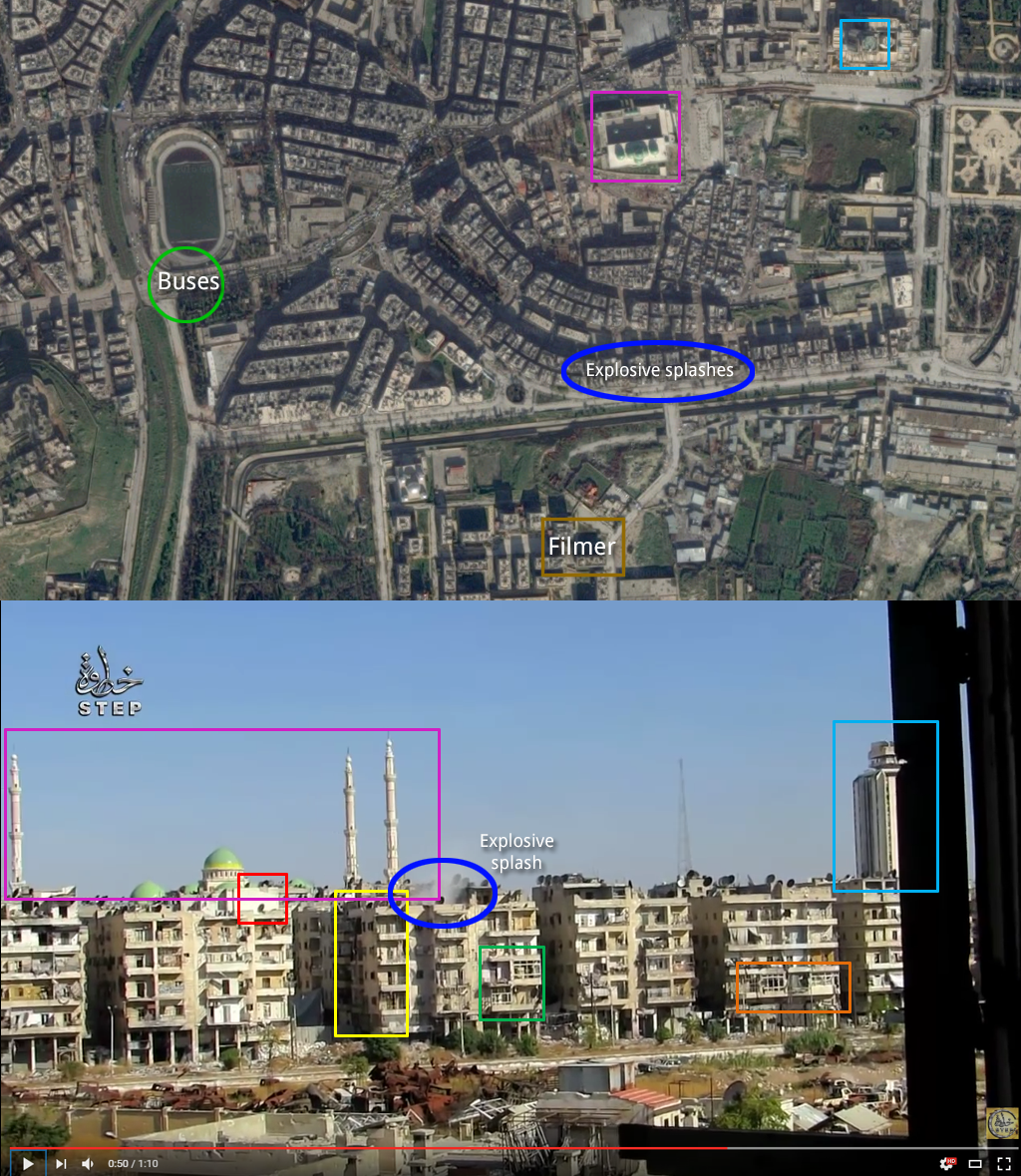
Figure 8 — Geolocation of the explosive splash shown in the Step News Agency video. (Courtesy: Step News Agency; Google Earth)
RT video and Russian Defence Ministry livecam
A video uploaded to YouTube by RT shows what appear to be three different smoke plumes. The location of the filmer can be geolocated to the barricade just east of the railway bridge at the 7th April Stadium (Wikimapia), and subsequently just east of the railway bridge. The green buses, allegedly waiting for rebels entering the exit corridor, are visible. The barricade is visible on TerraServer satellite imagery dated October 10.
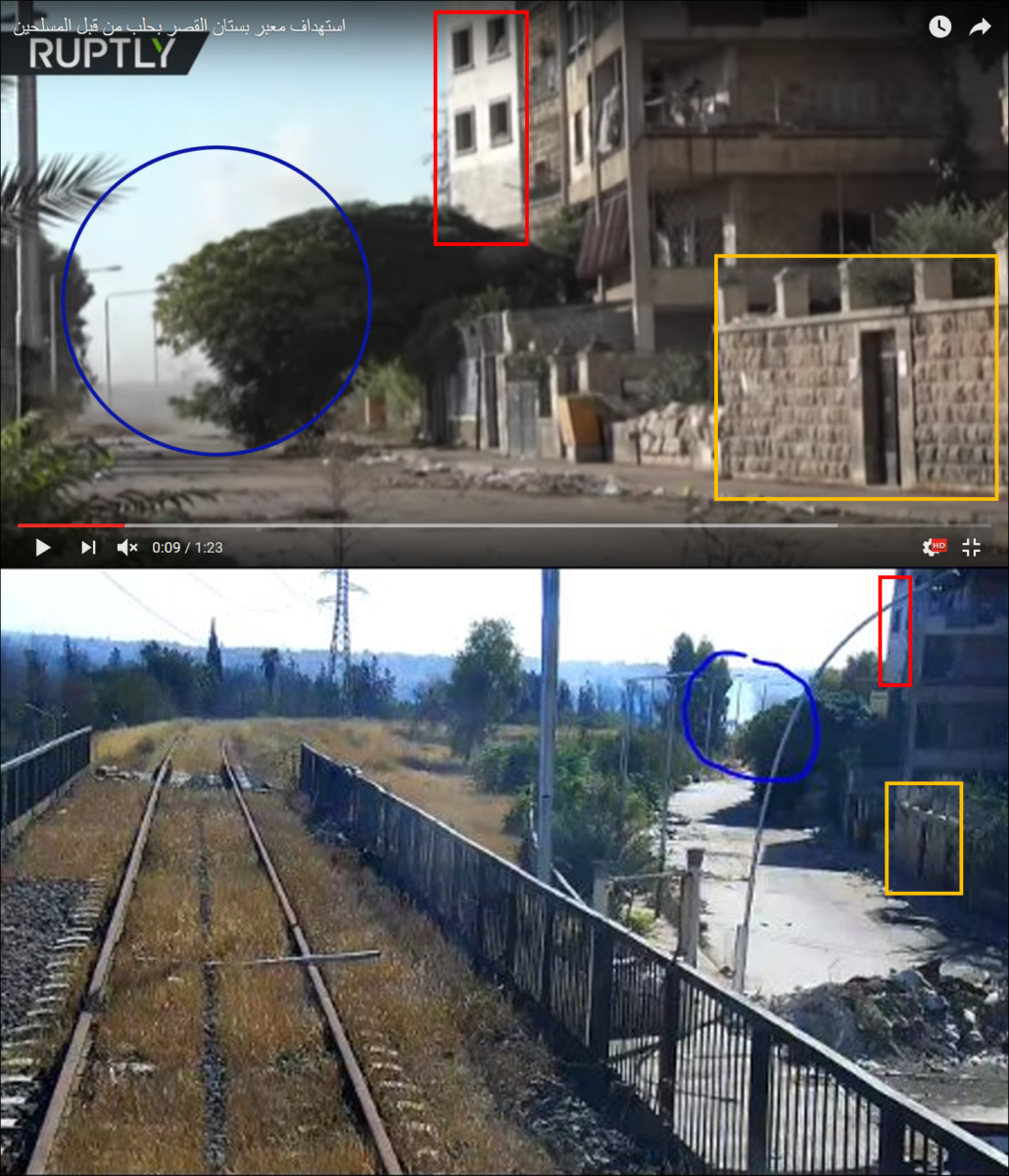
Figure 9 — The same or two different smoke plumes seen near the west-side of the Kher Eddin Al-Assadi street. (Courtesy images: RT (above); Russian MoD (below))
The approximate location of the first plume of smoke visible in the video can be geolocated to the road south of the barricade mentioned above. The same area saw smoke on the livecam (map) mounted on top of a pole on the railway bridge, looking south, as a Twitter user pointed.
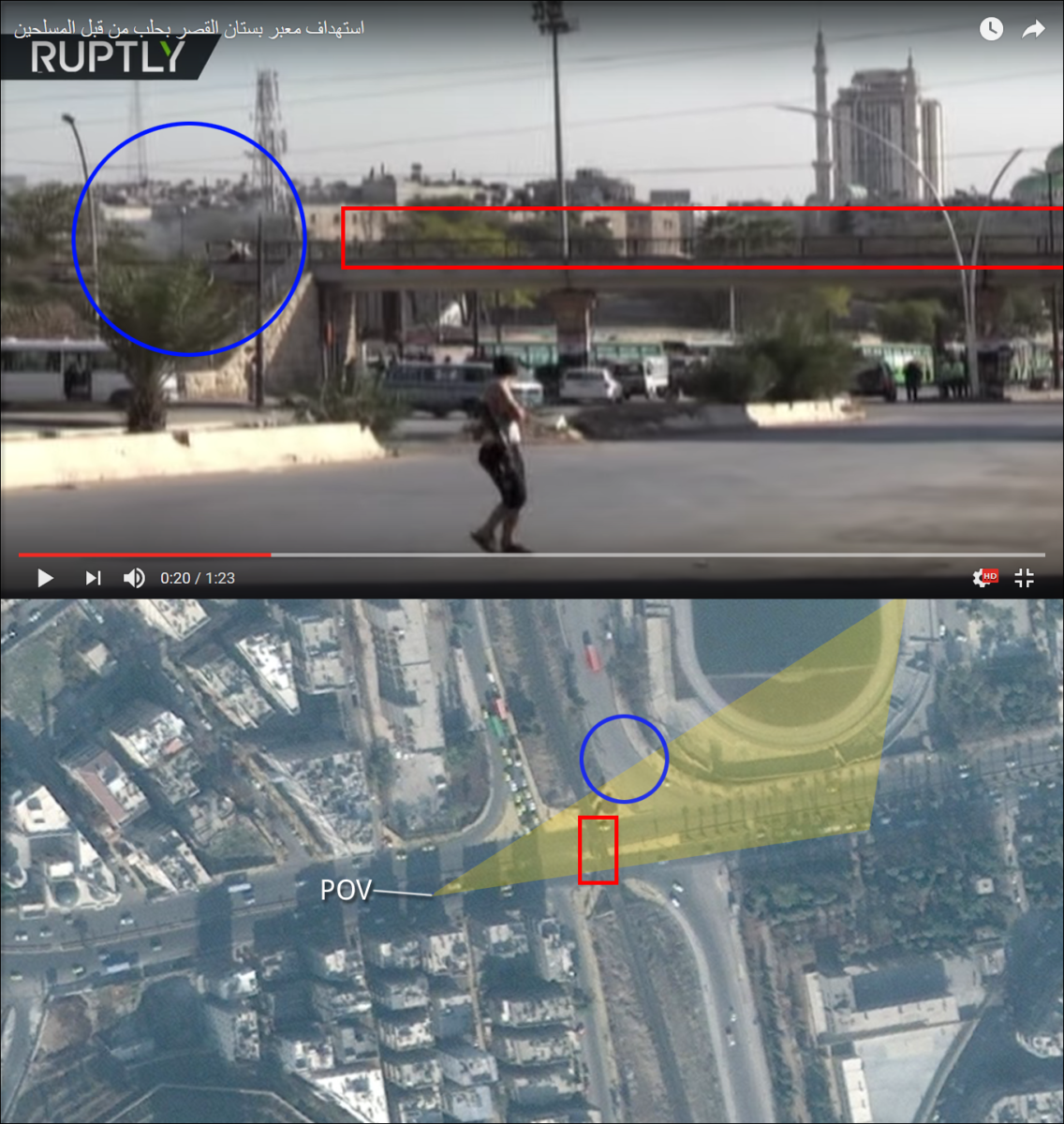
Figure 10 — The approximate location of a plume of smoke is circled in blue, somewhere down the the west side of the Kher Eddin al-Assadi street in Aleppo, Syria. (Courtesy: RT; Google Earth)
The approximate location of the second plume of smoke is circled in blue, somewhere down the the west side of the Kher Eddin Al-Assadi street.
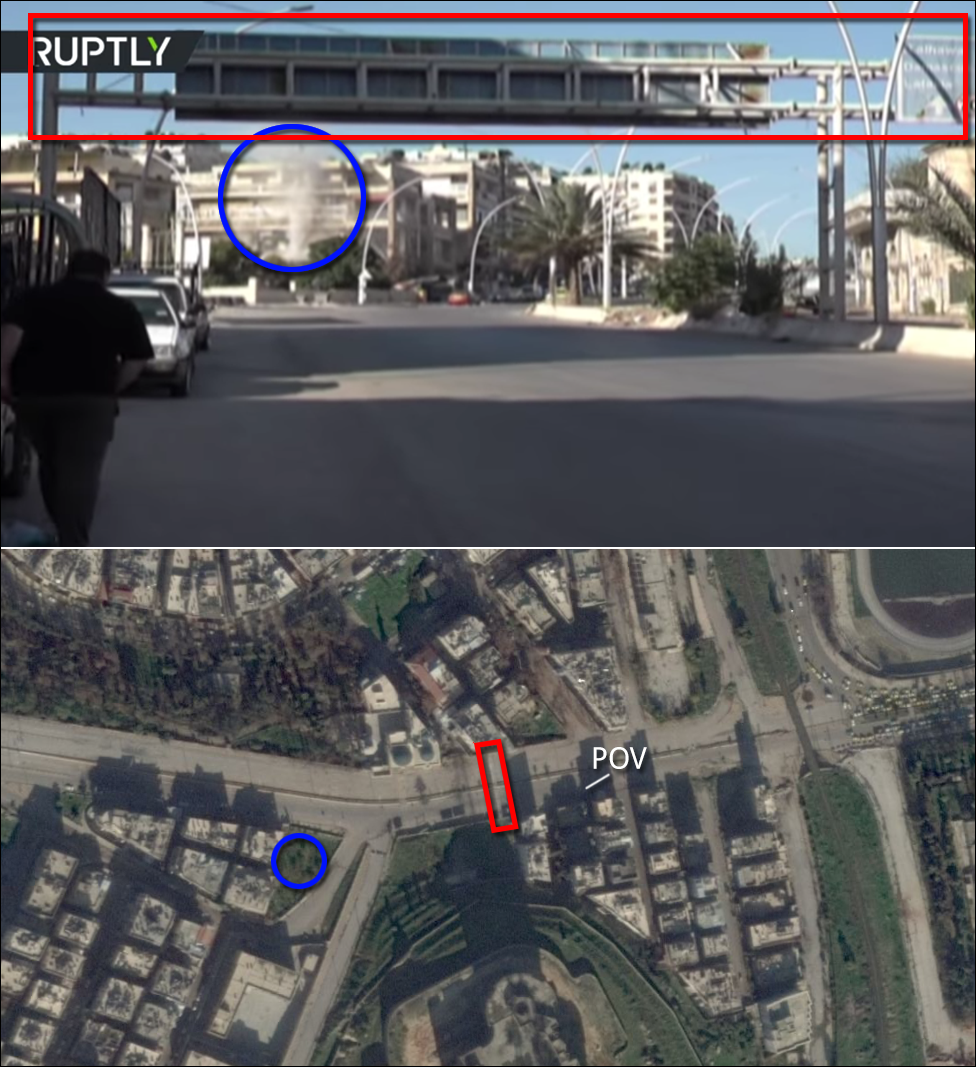
Figure 11 — The approximate location of a plume of smoke is circled in blue in Aleppo, Syria. (Courtesy: RT; Google Earth)
Abkhazian Network News Agency video
The Abkhazian Network News Agency (ANNA) also filmed at the exit corridor. The video, which has been used by others, clearly shows the location of at least six green buses south of the stadium. A ZS-88 (Cyrillic: ЗС-88) of the Syrian Arab Army (SAA), allegedly PsyOps, can also be seen under the railway bridge. It has a set of speakers on top of the vehicle and was broadcasting messages to rebel-held areas.
The video shows two different explosive splashes, one at 3:01 in the southern part of the field in the stadium, and one at 3:07 in the northern part of the stadium. The second mortar can be seen falling and exploding on the ground.

Figure 12 — Smoke plume in the southern part of the 7th April Municipal Stadium. (Courtesy: ANNA)
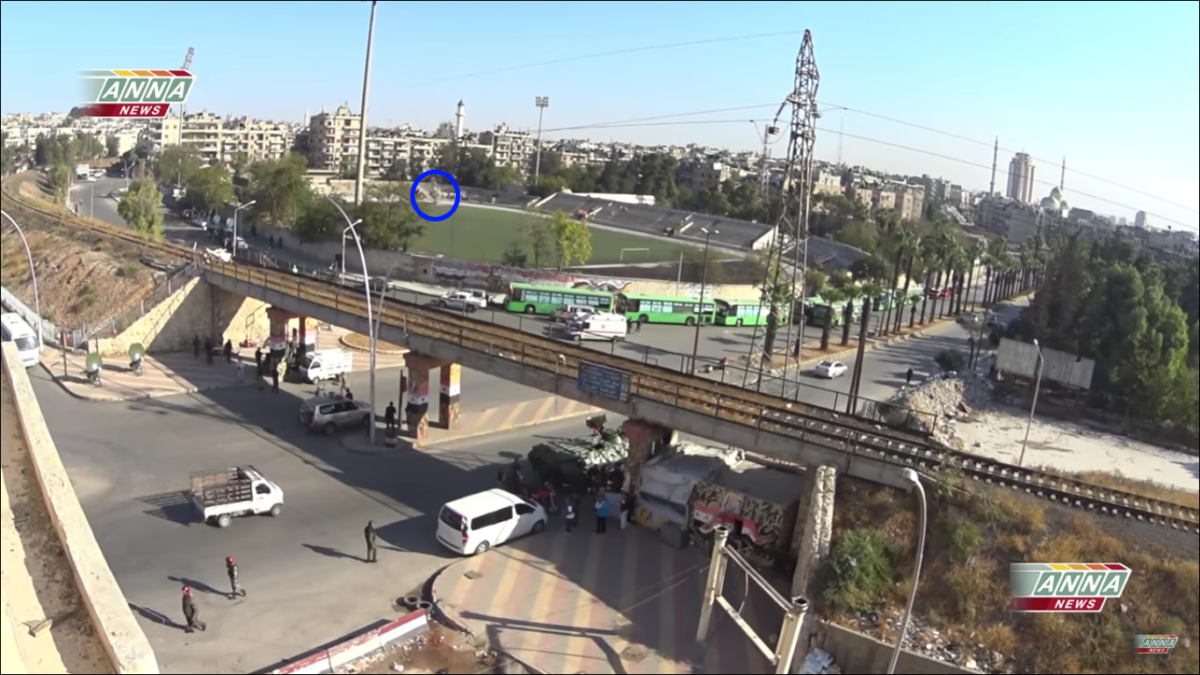
Figure 13 — Smoke plume in the northern part of the 7th April Municipal Stadium. (Courtesy: ANNA)
The footage was taken around 9:00 AM based comparing the data of SunCalc.
ITV video
The second geolocated video is from a reportage from ITV (link 1, link 2). The video was filmed from the Dedeman Hotel, and shows the same area as the first video, but different smoke plumes (Wikimapia).

Figure 14 — Smoke plume in south of the 7th April Municipal Stadium. (Courtesy: ITV; Google Earth)
Later, ITV’s Dan Rivers, who was in West Aleppo at the time, posted a picture which claims to show a hell cannon round.
Bakery we filmed yesterday totally destroyed at crossing point Bustan al Qasr – rebel rockets lying nearby pic.twitter.com/msauuhOKm0
— Dan Rivers (@danriversitv) October 20, 2016
Al Masdar News video
A video uploaded to YouTube by Al Masdar News, claimed to show the “dramatic moment rebels shell humanitarian corridor”. The position of the filmer has been geolocated to 36.200555, 37.134814 (Wikimapia), which is the Kher Eddin al-Assadi (east side) street west of the 7th April Municipal Stadium.

Figure 15 — Geolocation of the filming location of the video uploaded Al Masdar News, the rough location of the smoke plume appears to be in the Al-Hariri area.
The video shows how the green buses drive northwards from the place south of the stadium where they were reportedly waiting to transport individuals from rebel-held Aleppo. It is possible to make a rough calculation of the time of the day using SunCalc, a website that shows sun movement and sunlight phases during the given day at a give location. In this case, it seems to be around 13:00 local time.
The location of the smoke plume is slightly north-west of the filming location, seemingly in the Al-Hariri area.
SMART News Agency video
SMART News Agency also published a video from the same block of houses in Bustan al-Qasr on the same day as Step News Agency, but it did not show any explosive splashes or hell cannon rounds. They claim that civilians went to the exit corridor in the morning, but were shot at by SAA snipers. It seems they may refer to a different exit corridor, as this specific one is only for armed groups. They also claim that the SAA tried to advance into Bustan al-Qasr, which is southeast of the exit corridor and the area. Both claims could not be verified.
Murat Gazdiev (RT) video
A video uploaded by RT’s Murat Gazdiev shows an explosive splash south-east of the 7th April Municipal Stadium. The footage was taken around 13:00 to 14:00 according to SunCalc. No buses or police motors are visible at the southern end of the stadium. The footage appears to be filmed from the Dedeman Hotel, just like the ITV video.
Overhead view of one of the East-West #Aleppo crossings. Under relentless mortar fire by rebels… filmed this seconds after another impact. pic.twitter.com/Nt5NA6eOdn
— Murad Gazdiev (@MuradGazdiev) October 20, 2016
Other checkpoints
The vast majority of the media available online shows only the crossing point at the 7th April Municipal Stadium. There appears to be only one image claiming to show the exit corridor towards the Castello road, in an eerily empty state.
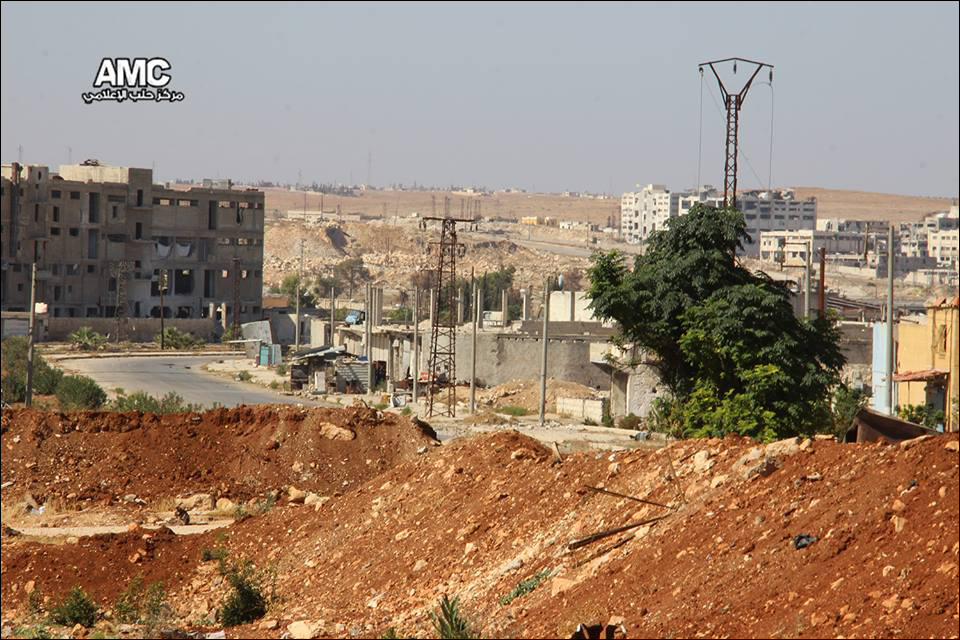
Figure 16 — The exit corridor towards the Castello road, in an eerily empty state. (Courtesy: AMC)
Other videos by Step News Agency and Aleppo Today shows the Salah al-Din exit corridor in an empty state as well.

Figure 17 — The Salah al-Din exit corridor appeared to be in an empty state as well. (Courtesy: Step News Agency)
In addition, at least two videos appear to show clashes between rebels and government forces. Firstly, there is a video of Ahrar al-Sham, a coalition of Islamist and Salafist units, targeting government forces trying to advance near the Sheikh Said frontline, which is close to one of the exit corridors. Secondly, there is another video showing clashes between Ahrar al-Sham and the SAA. The video can be geolocated to blocks inside the 1070 Apartments Project area.
Discussion
Considering the large number of explosive splashes around the location of the green buses at the exit corridor at the 7th April Municipal Stadium and the surrounding area, it is not surprising that neither armed rebels or civilians wanted to take this route. This adds context to the claims made by a reporter of Halab Today , a pro-rebel media outlet, that there was an “absence of civilians crossing #Bustan_algosr [Bustan al-Qasr] and the lack of any traffic crossing from besieged areas in Aleppo toward the regime’s control zones”.
Despite filming in the same place and, judging from the shadows, roughly the same time, Step News Agency fails to mention that rebel fire is falling onto one of the main roads to the exit corridor. They also fail to mention that this checkpoint is, according to the flyer, not an exit corridor for civilians but for armed groups.
From the visual evidence we have seen, the concentration of fire onto the 7th April Stadium checkpoint itself strongly suggests it was being deliberately targeted, almost certainly by rebel forces.
However, arguments have been raised why civilians would not want to leave East Aleppo, and videos (Video 1, Video 2) have shown civilians protesting against the “humanitarian pause”. There may well be a lack of trust between the civilians and rebels in rebel-held Aleppo and government forces, a situation that was exacerbated by the bombing of civilian areas, including the recent use of chlorine gas in the Al-Sukkari district as well as the Zabadiyah district recently, the failure of aid to reach East Aleppo during the previous truce.
This all is a topic of debate, and outside the scope of this open source survey.
Conclusion
From the open source information available, we can draw several conclusions:
First of all, according to the flyers dropped by the Syrian government, the exit corridor near the 7th April Municipal Stadium is an exit corridor for “armed groups”.
Secondly, the location of the buses at the 7th April Municipal Stadium was shelled with mortar fire: at least ten different smoke plumes can be geolocated near or very near the buses. The moment before impact of two mortars has been caught on camera.
Thirdly, there is visual evidence that there was shelling from rebel positions, in reply to what they claim was a small Syrian government offensive at the 7th April Municipal Stadium exit corridor. There does not appear to be a way to verify this claim at this time, as we have not found any open source information such as photos or videos that could be related to this claim. There have been clashes between rebels and Syrian government forces elsewhere around Aleppo.
Fourthly, At least one pro-rebel media outlet failed to mention shelling from the rebel side, despite being at the same location at roughly the same time.
Finally, without further information from the other checkpoints, it is difficult to draw conclusions about whether this is a concerted and unified effort to prevent civilians leaving opposition-held Aleppo, or only an attack on one particular checkpoint.
If you have any information that you think may be of use related to all of the above, feel free to contact us. Thanks to Nathan Ruser for providing detailed information on territorial control within Aleppo.
